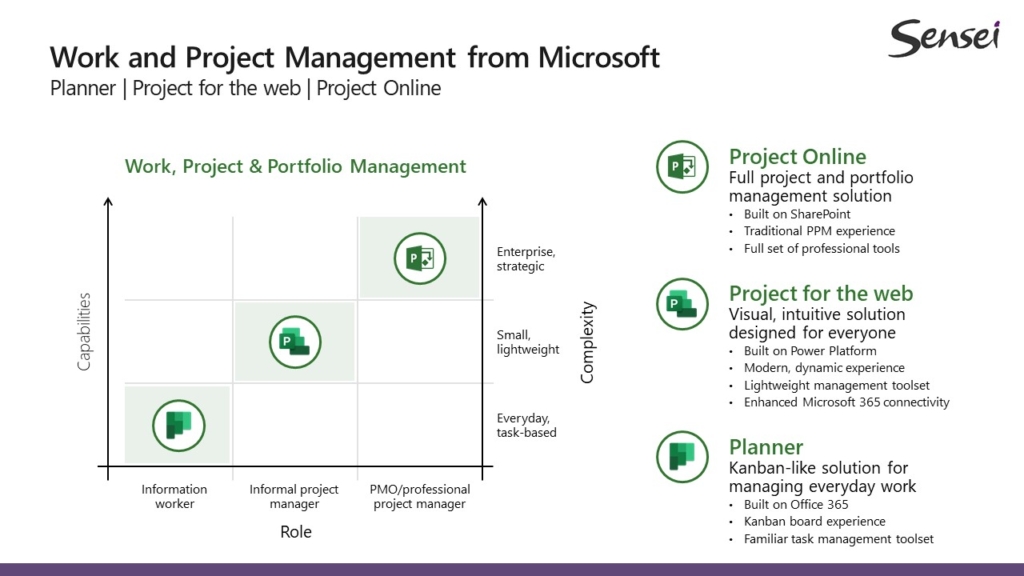Following our recent webinars, The Future of Microsoft Project Online (Part 1) & The Future of Microsoft Project Online (Part 2), I thought I would summarise Microsoft’s latest developments for the project and portfolio management space, what this means for your PMO, and what the path moving forward may look like for your PMO.
The current state of Microsoft PPM
Whilst the Granade Dame, Microsoft Project Online has capably served Microsoft PPM users for many years now, we have seen that over recent years Microsoft has been very public with their intention to focus all future investments on Project for the Web and the use of the Power Platform (see press release here) to create PPM solutions in the future.
These advancements from Microsoft have been driven by the evolution of organisations and their people. Expectations have changed. And the technology has finally caught up to be able to meet those expectations. Organisations need a no-code/low-code way to digitise their processes and to keep up with their own change, as well as the changing ways of working as industry best practice, methodologies and tools evolve. Rigid tools that you have to adapt to are no longer suitable.
The user change is even more pronounced. People need to be able to work with simpler tools and tools that align to how they want to work, that give them choice. Yet all of them need to contribute to reporting and the overall process. Else we see that they simply don’t use the tools. This has happened to PMO’s with reporting built on Project Online many times.
While this describes the general evolution in tools and the industry, in the instance of Project and Portfolio Management, many factors have been leading to the point of this proactive evolution, including:
- The universal business focus on strategy which is not well supported in Project Online;
- The inclusive push to support all levels of user maturity and not just those using MS Project in Project Online;
- The strong efforts to break down independent silos within a business which requires a horizontal digital enablement, not just a roll-up of schedules.
The problem is that Project Online has not kept up with this evolution. It is SharePoint based. It is harder to change, and is centered on MS Project as a scheduling tool. A certain level of maturity is implied and workarounds are possible yet they don’t quite allow us to evolve.
What next?
You need to begin planning to move off Project Online. But you are not alone. Microsoft has provided a new direction, and that is to use Project for the Web in conjunction with the Power Platform. But what if you already have Project Online? Microsoft has stated that there will be no further innovation in Project Online, instead, this goes to Project for the web. But there is also Planner, and complete out of the box Software as a Service solutions such as Altus that are built on the Power Platform. This has left some organisations confused and apprehensive about what that means for their customised Project Online instances. They are concerned about what the key differences are between the two platforms, and how they will be able to best prepare for the migration when the time comes.
What are your Microsoft based options?
Given the variety of choices with Microsoft’s PPM options, an organisation can easily become overwhelmed, so let us first explain the three different Microsoft Project Management tools.
- Microsoft Planner is a great tool for work and task management for many of the people we might call information workers. Planner uses tasks as cards and a board. It is very easy to use and good for those who want to manage tasks but nothing else, and are not project managers.
- Microsoft Project Online is for the professional project manager and the PMO who need to manage large, complex projects and coordinate a portfolio of projects and resources. You can use it for smaller projects as well, but the tasks are managed in MS Project.
- Microsoft Project for the web is targeted at the informal project manager who needs to manage small and light-weight projects, like the majority in an organisation actually do, hence it has a simpler scheduling tool than MS Project with growing functionality.

Whilst Planner is the perfect tool for everyday work and task management, if you require something customisable or more in-depth for complicated projects, Project Online or Project for the web would be better suited for your team.
Project Online is best suited for enterprise project and portfolio management, as it is a more complex system for monitoring projects, work, and costs; whilst Project for the web is very easy to adopt and use, however unfortunately it can come with limited functionality and the requirement for customisation although it has a lot of capability for customisation through the Power Platform.
Note that Microsoft Project Online and Microsoft Project for the web are two distinct products, yet they both address project collaboration and teamwork. MS Project is a scheduling tool that can be used on its own or within Project Online and can also be imported into Project for the web (and integrated into other tools such as Altus. MS Project isn’t going anywhere even if Project Online is).
We have compared these two tools in-depth for you in the feature matrix table below.
| Feature | Project Online | Project for the web |
|---|---|---|
| Current & future platform | ❌ | ✔️ |
| Cloud-based | ✔️ | ✔️ |
| Power Platform based | ❌ | ✔️ |
| Easy to extend | ❌ | ✔️ |
| Aimed at the end-user | ❌ | ✔️ |
| Minimal training required | ❌ | ✔️ |
| Choose your own task tool | ❌ | ❌ |
| Power BI for reports | ✔️ | ✔️ |
| Strategy & benefits management (partial in Project Online and why we created Altus) | ❌ | ❌ |
| Portfolio & program management (not fully and why we created Altus) | ❌ | ❌ |
The creation of Project for the web has given Microsoft an opportunity to re-imagine work management, whereby instead of building feature by feature they have been able to focus on providing capabilities that meet the changing needs of work management.
How Project for the web will continue to be built out over time will be based off tracking feature usage and user feedback. Microsoft is working with partners across the globe, such as Sensei, to ensure together they are providing features that meet real users’ needs.
To put it simply:
- A great advantage of Project Online is that it uses MS Project, but that is also a disadvantage in the new world as it only uses MS Project and MS Project is not suitable for all types of work or all maturity levels of user.
- Rather than being developed on SharePoint as Project Online is, Project for the web has been built on the Power Platform. This is actually an advantage but it is a platform, so you don’t see all of the functionality from the beginning you have to create it in some cases.
- Whilst Project Online uses SharePoint for collaboration, Project for the web utilises Microsoft Teams and Microsoft Groups to bring its users together. This also means you can work within Teams and gain its advantages.
- Project Online’s advantage of having an advanced scheduling capability, which also made it complex, has now been augmented with Project for the web. But what about those who need the power of MS Project (hint: MS Project is not going away).
There is great potential and opportunity in moving Project Online or any PPM solution to be built on the Power Platform, as organisations can now integrate other cloud-based tools and capabilities to their PPM solution, resulting in a fully functioning, adaptive work management solution.
To achieve the above, organisations must first ensure they work through their various requirements and unique instances to consider their Microsoft project and portfolio tool options.
Microsoft gives you the puzzle pieces, but it’s up to you to piece them together
Whilst the varying Microsoft project management tools, combined with the Power Platform and Microsoft 365, provides users with improved functionalities, it is still up to the organisation to create a functioning solution that fits with the organisation’s unique ways of working.
It is crucial for PMOs to remember that project portfolio management is more than just the toolset you use. Implementing tools without a matching level of process discipline is a futile exercise, which will leave your business frustrated at the wasted time and money.
Once your process is defined and you implement a Microsoft tool such as Project for the web (you wouldn’t implement or make large changes to Project Online at this point), you need to then extend the functionality using:
- Power Apps for your data and registers;
- Power Automate for your workflow and process enablement. This is one of the biggest opportunities;
- Power BI for dashboards and reports and to bring the data alive.
This sounds like hard work, but it isn’t necessarily. This blog isn’t about the Sensei tools but we have built a mature solution that includes all of the above for you. And your own internal IT skills will grow in the Power Platform and you will be amazed at what gets configured.
Here we provide a comparison of Project Online and the Power Platform overall:
| Feature | Project Online | Power Platform |
|---|---|---|
| Reporting | Power BI & SSRS | Power BI & SSRS |
| Workflow | SharePoint Workflow (soon to be decommissioned) | Power Automate |
| Collaboration | SharePoint Project Team Site (limitations of volume) | Teams |
| Portfolio/Programs | Project Online doesn’t have this concept (workaround) | Power Apps |
| Resource Management | Project Online Specific | Power Apps (Altus enhancements) |
| Financial management | Financials in schedule only | Power Apps (Altus enhancements) |
| Scheduling | MS Project | Project for the web (Sensei specific support all schedule tools) |
| Artifacts (Risks, Issues, etc) | SharePoint Project Team Sites | Power Apps |
| Integration | Custom Development | Dataverse |
Summary
Don’t panic. You still have quite a lot of time, the end date for Project Online has not been announced. So you have time to plan an orderly transition that works for you.
- You are losing Project Online but you are gaining a lot of choice such as Project for the web or Altus, which actually takes the functionality far beyond Project Online.
- Project for the web is mainly focused on the management of tasks, so you do need to consider how you will get the rest of the functionality. That is where the Power Platform comes in, but do you build or buy? Building and supporting is a lot harder of course.
- You are not losing MS Project. That is what most people fear but MS Project is not going anywhere. Depending on the overall enterprise solution you chose, you have options on how MS Project can be integrated in.
- Yes, you are losing Project Online but you are gaining the ability to truly digitise your business process by using Power Apps and Power Automate, which will give you an even better and more aligned solution overall.
- You do need to decide how you will get there. Do you use Project for the web and customise? Do you use a solution such as Altus which gives it all to you out of the box?
If your organisation will be affected by the inevitable shift from Project Online, or maybe it is just time for an upgrade, Sensei is here to help you navigate through all of your questions and concerns. With an exclusively intimate knowledge of the Microsoft solutions and roadmap, we encourage you to get in touch with our Sensei experts for their insight when discussing your unique business needs.
By Ryan Darby
With over 18 years in PPM and Work Management Ryan has developed into a well-rounded professional who can always be approached and asked for advice. With experience in over 100 PPM implementations and Ryan’s excellent people skills, he is always able to provide quality advice and direction. Ryan is an industry standard expert on all levels of PMI, PMO and Scaled Agile.



